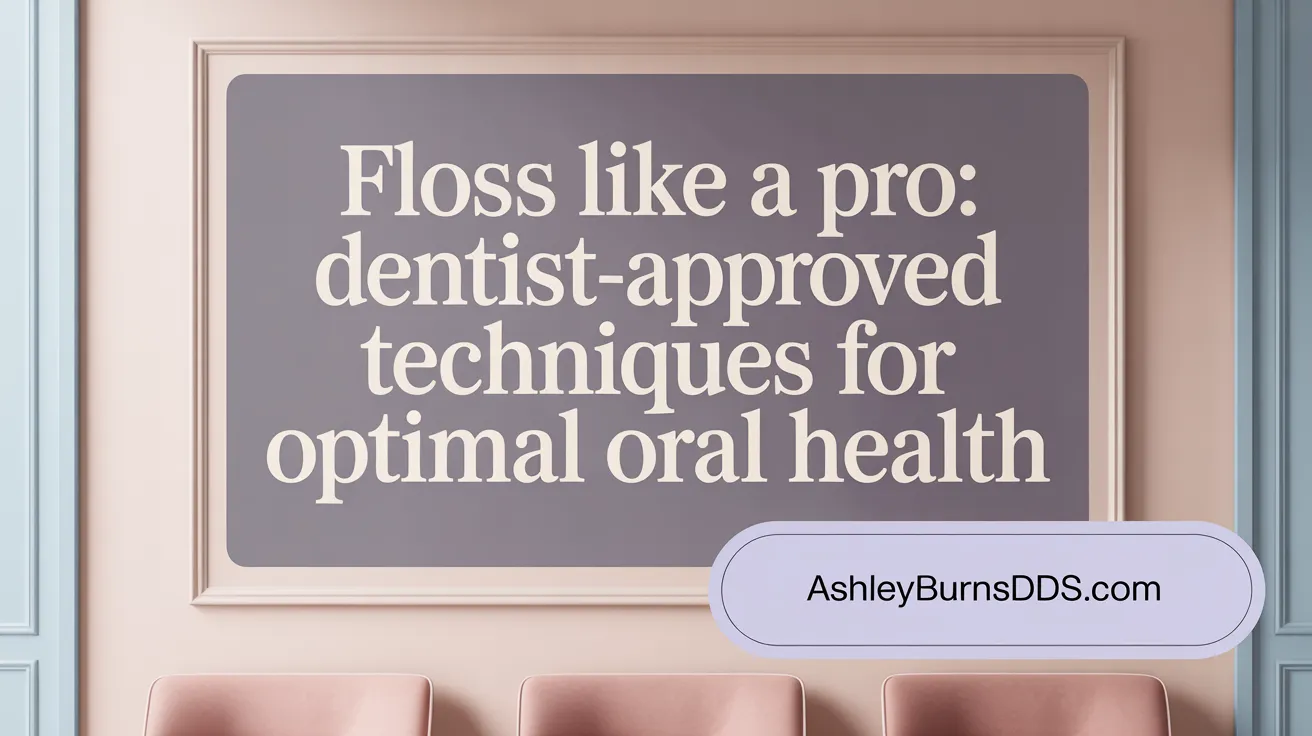Why Flossing Matters More Than You Think
Flossing is a cornerstone of effective oral hygiene, recommended by dental professionals worldwide. Beyond just brushing, flossing cleans the hard-to-reach spaces between your teeth and under the gums where plaque and food debris accumulate. This article uncovers the dentist-approved flossing techniques, tools, benefits, common mistakes, and expert insights to help you develop a daily habit that promotes strong teeth and healthy gums.
The Critical Benefits of Daily Flossing for Oral Health
 Flossing plays a vital role in maintaining optimal oral health by helping to remove plaque and food debris from areas that brushing alone cannot reach. These tight spaces between teeth and under the gum line are common hiding spots for bacteria, which produce acids that cause cavities and lead to gum diseases like gingivitis and periodontitis. Regular interdental cleaning, whether through traditional flossing, interdental brushes, or water flossers, significantly reduces plaque buildup and prevents the hardening of plaque into tartar—a substance that only dentists can remove. Studies endorsed by the American Dental Association (ADA) underline that daily flossing or interdental cleaning reduces gingivitis and interproximal caries, promoting healthier gums and teeth.
Flossing plays a vital role in maintaining optimal oral health by helping to remove plaque and food debris from areas that brushing alone cannot reach. These tight spaces between teeth and under the gum line are common hiding spots for bacteria, which produce acids that cause cavities and lead to gum diseases like gingivitis and periodontitis. Regular interdental cleaning, whether through traditional flossing, interdental brushes, or water flossers, significantly reduces plaque buildup and prevents the hardening of plaque into tartar—a substance that only dentists can remove. Studies endorsed by the American Dental Association (ADA) underline that daily flossing or interdental cleaning reduces gingivitis and interproximal caries, promoting healthier gums and teeth.
Beyond oral health, proper flossing habits are linked to systemic health benefits. Bacteria from the mouth can enter the bloodstream through inflamed gum tissue, contributing to issues like heart disease, stroke, and diabetes. Maintaining a consistent interdental cleaning routine not only prevents dental problems but also supports overall well-being.
In practice, effective flossing involves using about 18 inches of floss wound around fingers, gently curving it around each tooth in a C-shape, and moving it up and down to clean beneath the gum line without causing trauma. The use of suitable tools such as floss picks or water flossers can make the process easier and more effective, especially for those with braces or limited dexterity. By incorporating daily interdental cleaning into their routine, individuals can enjoy a healthier mouth and potentially reduce the risk of related systemic health issues.
| Benefit | Description | Importance |
|---|---|---|
| Plaque removal | Cleans areas between teeth where brushes can't reach | Prevents cavities and gum inflammation |
| Tartar control | Stops plaque from hardening into tartar | Avoids professional removal and periodontal disease |
| Gum disease prevention | Reduces bleeding and inflammation | Promotes healthier gums and reduces tooth loss |
| Overall health | Lowers risk of systemic conditions linked to oral bacteria | Supports heart, diabetes, and general health |
| User options | Floss, interdental brushes, water flossers | Meets different needs and preferences |
Dentist-Recommended Flossing Techniques: How to Floss Like a Pro
 Proper flossing technique is essential for maintaining healthy teeth and gums, and dentists emphasize several core principles to ensure effectiveness and safety. First, the appropriate length of floss is about 18 inches, which allows for effective cleaning without reusing contaminated sections. Wrapping most of the floss around the middle fingers of each hand provides control and reach.
Proper flossing technique is essential for maintaining healthy teeth and gums, and dentists emphasize several core principles to ensure effectiveness and safety. First, the appropriate length of floss is about 18 inches, which allows for effective cleaning without reusing contaminated sections. Wrapping most of the floss around the middle fingers of each hand provides control and reach.
Next, the core of effective flossing is the C-shape technique. Gently guiding the floss into the space between teeth, curve it into a C-shape around the side of each tooth. This shape helps clean just beneath the gumline and removes plaque effectively. The floss should then be moved up and down in a gentle, controlled manner—using a light, back-and-forth or up-and-down motion—to dislodge food debris and plaque.
It is crucial to use a clean section of floss for each tooth to prevent the transfer of bacteria. As you progress, unwind fresh floss from your fingers to maintain hygienic standards.
Some individuals may prefer alternate interdental tools such as interdental brushes, pre-threaded flossers, or water flossers, especially if they have braces, bridges, or sensitive gums. These tools can sometimes offer easier or more thorough cleaning.
Consistency in flossing—at least once daily—is vital for preventing gum disease and tooth decay. When combined with regular brushing and routine dental checkups, proper flossing significantly contributes to overall oral health.
For more detailed guidance on proper flossing technique, searching for "proper flossing technique ADA guidelines" provides comprehensive, authoritative information.
Step-by-Step Guide and Tips for Safe and Effective Flossing

Choosing the right floss
Selecting the appropriate floss can make a big difference in your flossing experience. You can choose between waxed or unwaxed floss, depending on your preference. Waxed floss tends to slide more easily between tight teeth and is less likely to fray, making it suitable for most people. Unwaxed floss is thinner and can be easier to maneuver in narrow spaces but may shred more easily. For those with braces or dental work, specialized options like superfloss or interdental brushes may be recommended.
Preparing to floss
Start by cutting about 18 inches (around 45 centimeters) of dental floss. Wind most of it around the middle fingers of each hand, leaving a few inches of floss to work with. Hold the floss gently between your thumbs and index fingers, with enough slack to maneuver comfortably. Before inserting the floss, ensure your hands are clean, and position yourself comfortably to reach all areas of your mouth.
Stepwise flossing instructions
Carefully guide the floss into the space between two teeth using a gentle back-and-forth rubbing motion. When the floss reaches the gum line, curve it into a C-shape around the side of the tooth. Gently rub the floss up and down against the tooth surface and under the gumline to remove plaque and debris.
Move the floss to a new, clean section and repeat the process on the adjacent tooth. Continue this method for all teeth, including the back molars and the areas behind your last teeth.
Safety tips
Never force the floss between tight teeth, as this can injure your gums. If you experience bleeding, it’s often a sign of inflammation, which typically improves with regular flossing. Avoid reusing the same section of floss to prevent bacteria transfer and fraying. Choosing floss products with the ADA Seal of Acceptance ensures the floss is proven safe and effective.
Daily routine integration
Make flossing a daily habit, ideally once per day, either before or after brushing. Most experts recommend doing it at night to reduce plaque buildup overnight. Regular flossing not only helps maintain healthy gums but also prevents cavities, bad breath, and contributes to overall health by reducing the risk of gum disease-related conditions.
Choosing Your Floss: Types and Tools Recommended by Dentists
 When it comes to maintaining optimal oral health, selecting the right floss and interdental cleaning tools is crucial. There are various options available, each designed to address different dental needs and personal preferences.
When it comes to maintaining optimal oral health, selecting the right floss and interdental cleaning tools is crucial. There are various options available, each designed to address different dental needs and personal preferences.
Traditional dental floss is the most common choice. It comes in several types: waxed, unwaxed, flavored, woven or braided, and superfloss. Waxed floss tends to slide easily between tight teeth and is less likely to shred, making it suitable for densely spaced teeth. Unwaxed floss is thinner, which some find easier to maneuver in tight spaces, though it might fray more often. Flavored floss adds a pleasant taste that can make daily flossing more enjoyable (Best dental floss according to dentists).
Floss picks are modern alternatives—small plastic devices with a U-shaped end holding floss. They are convenient and easy to use, especially for children or those with limited manual dexterity, but they are not reusable and may not thoroughly clean all areas (Floss picks overview).
Beyond string floss, devices like interdental brushes and water flossers provide effective cleaning options. Interdental brushes are small, cone-shaped or cylindrical brushes with fine bristles, effective around bridges, implants, and larger gaps. They come in different sizes and are especially useful for individuals with wider spaces between teeth (Interdental brushes uses).
Water flossers shoot a pressurized stream of water to dislodge debris and plaque, making them ideal for people with braces, gum sensitivities, or arthritis. While not a complete substitute for traditional floss, they complement regular brushing and flossing routines (Water flossers for teeth cleaning).
Specialized floss products are available for individuals with braces, bridges, or dental implants. Superfloss, for example, has a stiff end for threading around orthodontic appliances (Superfloss for braces and bridges.
When choosing the most suitable method, consider factors like the spacing of your teeth, comfort, and ease of use. Consulting with your dentist can help you determine the best tools for your specific oral health needs (Consulting a dentist for flossing advice.
Ultimately, the best flossing tool is one that you will use consistently and correctly. Regular use of the right product makes a significant difference in removing plaque, preventing gum disease, and maintaining a healthy smile (Benefits of regular flossing.
| Flossing Tools | Pros | Cons | Best For |
|---|---|---|---|
| Traditional waxed floss | Durable, easy to slide, flavorful options | Can shred in tight spaces | Most users, tight teeth |
| Unwaxed floss | Thinner, may clean tight spaces better | Less durable | Those with closely spaced teeth |
| Floss picks | Convenient, easy for beginners and kids | Less effective for thorough cleaning | Quick cleaning on the go, kids |
| Interdental brushes | Effective around implants, bridges | Requires correct size selection | Wide gaps, braces |
| Water flossers | Gentle, good for braces and gum sensitivity | Expensive, needs power source | Orthodontic devices, sensitivity |
Choosing the right dental floss or interdental cleaner involves considering your specific dental conditions, comfort level, and consistency in use. Regular consultation with your dentist ensures your oral hygiene routine remains effective and tailored to your needs (ADA flossing recommendations.
Avoiding Common Mistakes: Myths and Misconceptions about Flossing

What are common mistakes and misconceptions about flossing to avoid?
Many people believe that flossing isn't necessary or that it can hurt teeth if not done correctly. A common error is snapping or forcing the floss into the gums, which can cause bleeding and injury. Proper technique involves gently sliding the floss up and down in a controlled manner, creating a C-shape around each tooth.
Another frequent mistake is reusing the same section of floss for multiple teeth. This practice can spread bacteria from one part of the mouth to another, increasing the risk of infections. It's important to use a fresh section of floss for each tooth.
Flossing too aggressively can damage gum tissue, leading to recession and sensitivity. Gentle, careful movements are essential to prevent harm.
There is also a misconception that brushing alone is enough for oral health. While brushing removes plaque from tooth surfaces, flossing targets the areas between teeth and under the gumline that brushing cannot reach effectively.
Additionally, some overlook the importance of flossing behind the back teeth or forget to floss daily. Consistent flossing combined with regular dental checkups helps prevent plaque buildup, cavities, and gum disease.
Using incorrect or incompatible floss types, or skipping flossing altogether, diminishes the benefits and can compromise gum health. Proper technique, routine, and awareness of these misconceptions are vital for maintaining oral hygiene.
Making Flossing a Daily Habit for Lifelong Oral Health
Flossing is a simple yet powerful practice that complements brushing to keep your teeth and gums healthy. By understanding the proper techniques, selecting the right tools, and avoiding common errors, you can maximize the benefits of daily flossing. Dentists agree that regular interdental cleaning not only spotlights a beautiful smile but also plays a key role in preventing serious dental and systemic health conditions. Incorporate flossing into your oral care routine today and consult your dental professional to tailor the best flossing approach for your needs.
